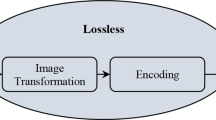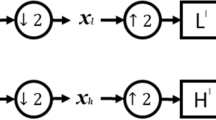Abstract
The inherent issue associated with any digital images is its underlying redundancy and large dimension size, which requires a huge amount of storage space as well as higher bandwidth for transmission over a wireless channel. This factor has inspired the researchers to arrive with an optimal solution that compresses digital images with considerable visual quality. However, the researches in the area of images compression are still very active and propose different solutions based on the modern technologies such as artificial intelligence and machine learning algorithms to establish an optimal mechanism to reduce data communication cost that requires high computing process, high storage cost, and parallel architecture. In this research, modelling of the joint approach based on discrete wavelet transform as well as Back propagation neural network for image compression was carried out to achieve optimal balance among compression ratio and visual image quality in terms of PSNR. Experiments had been achieved, the results obtained based on comparative analysis with three different techniques DWT, BPNN, and joint DWT-BPNN are discussed. The study outcome shows better performance achieved by the proposed joint DWT-BPNN in terms of compression ratio, Computational cost, and peak signal to noise ratio (PSNR) with 10 input image samples. However, the performance of the proposed system for the image compression system can be further enhanced in future research work by modifying the different network configurations and parameters. Based on the experimental observations practically, it can be realized that the joint operation of both DWT and BPNN can compress images without much degrading the visual quality of images.





Similar content being viewed by others
Explore related subjects
Discover the latest articles and news from researchers in related subjects, suggested using machine learning.Availability of Data and Materials
Medical image (MRI) dataset available at https://sites.google.com/view/calgary-campinas-dataset/home.
Code Availability
Custom code available and developed by the author.
References
Zhai, G., Xiongkuo, M. (2020). Perceptual image quality assessment: a survey. Science China Information Sciences 63(11): 211301.
Shantagiri, P., & Saravanan, N. (2013). Pixel size reduction loss-less image compression algorithm. International Journal of Computer Science and Information Technology, 5, 87–95. https://doi.org/10.5121/ijcsit.2013.5208
Hussain, A., Al-Fayadh, A., & Radi, N. (2018). Image compression techniques: A survey in lossless and lossy algorithms. Neurocomputing. https://doi.org/10.1016/j.neucom.2018.02.094
Vrindavanam, J., Chandran, S., & Mahanti, G. K. (2012). A survey of image compression methods. In Proceedings on international conference and workshop on emerging trends in technology.
Rehman, M., Sharif, M., & Raza, M. (2014). Image compression: A survey. Research Journal of Applied Sciences, Engineering and Technology, 7(4), 656–672.
Kaur, R., & Rajneesh, R. (2018). ROI and non-ROI based medical image compression techniques: A survey and comparative review. In First international conference on secure cyber computing and communication (ICSCCC). IEEE.
Liu, F., Hernandez-Cabronero, M., Sanchez, V., Marcellin, M. W., & Bilgin, A. (2017). The current role of image compression standards in medical imaging. Information, 8(4), 131.
Bhavani, S., & Thanushkodi, K. (2010). A survey on coding algorithms in medical image compression. International Journal on Computer Science and Engineering, 2(5), 1429–1434.
Khandwani, F. I., & Ajmire, P. E. (2018). A survey of lossless image compression techniques. International Journal of Electrical Electronics & Computer Science Engineering, 5(1), 39–42.
Dixit, P., et al. (2018). Traditional and hybrid encryption techniques: A survey. In Networking communication and data knowledge engineering (pp. 239–248). Springer.
Singh, S., Kumar, V., & Verma, H. K. (2007). Adaptive threshold-based block classification in medical image compression for teleradiology. Computers in Biology and Medicine, 37(6), 811–819.
Chikouche, D., Benzid, R., & Bentoumi, M. (2008). Application of the DCT and arithmetic coding to medical image compression. In Proceedings of the 3rd International Conference on Information and Communication Technologies: From Theory to Applications (ICTTA ’08), Damascus, Syria (pp. 1–5).
Khashman, A., & Dimililer, K. (2008). Image compression using neural networks and Haar wavelet. WSEAS Transactions on Signal Processing, 4(5), 330–339.
Ashraf, R., & Akbar, M. (2006). Absolutely lossless compression of medical images. In Proceedings of the IEEE-EMBS 27th annual international conference of the engineering in medicine and biology society, Shanghai, China (pp. 4006–4009).
Northan, B., & Dony, R. D. (2006). Image compression with a multiresolution neural network. Canadian Journal of Electrical and Computer Engineering, 31(1), 49–58.
Sridhar, V. "A review of the effective techniques of compression in medical image processing." International Journal of Computer Applications 97.6 (2014).
Sridhar, V. (2014). Computational modelling of image coding using ROI based medical image compression. International Journal of Computer Applications 108(5).
Juliet, S., Rajsingh, E. B., & Ezra, K. (2016). A novel medical image compression using Ripplet transform. Journal of Real-Time Image Processing, 11(2), 401–412.
Sridhar, V. (2015). VCAR: Vedic compression algorithm over region of interest on radiological image. In International conference on emerging research in electronics, computer science and technology (ICERECT). IEEE.
Brahimi, T., Boubchir, L., Fournier, R., & Naït-Ali, A. (2017). An improved multimodal signal-image compression scheme with application to natural images and biomedical data. Multimedia Tools and Applications, 76(15), 16783–16805.
Das, S., & Kundu, M. K. (2013). Effective management of medical information through ROI-lossless fragile image watermarking technique. Computer Methods and Programs in Biomedicine, 111(3), 662–675.
Lucas, L. F., Rodrigues, N. M., da Silva Cruz, L. A., & de Faria, S. M. (2017). Lossless compression of medical images using 3-d predictors. IEEE Transactions on Medical Imaging, 36(11), 2250–2260.
Anusuya, V., SrinivasaRaghavan, V., & Kavitha, G. (2014). Lossless compression on MRI images using SWT. Journal of Digital Imaging, 27(5), 594–600.
Ayoobkhan, M. U. A., Chikkannan, E., & Ramakrishnan, K. (2017). Lossy image compression based on prediction error and vector quantisation. EURASIP Journal on Image and Video Processing, 1, 35.
Selvi, G. U. V., & Nadarajan, R. (2017). CT and MRI image compression using wavelet-based contourlet transform and binary array technique. Journal of Real-Time Image Processing, 13(2), 261–272.
Mofreh, A., Barakat, T. M., & Refaat, A. M. (2016). A new lossless medical image compression technique using hybrid prediction model. Signal Processing: An International Journal (SPIJ), 10(3), 20.
Perumal, B., & PallikondaRajasekaran, M. (2016) A hybrid discrete wavelet transform with neural network back propagation approach for efficient medical image compression. In International conference on emerging trends in engineering, technology and science (ICETETS).
Calgary-Campinas Public Brain MR Dataset. Retrieved on 04 July 2020, from https://sites.google.com/view/calgary-campinas-dataset/home.
Acknowledgements
Not applicable.
Funding
Not applicable.
Author information
Authors and Affiliations
Corresponding author
Ethics declarations
Conflict of interest
The authors declare that they have no conflict of interest.
Additional information
Publisher's Note
Springer Nature remains neutral with regard to jurisdictional claims in published maps and institutional affiliations.
Rights and permissions
About this article
Cite this article
Suma Modelling of Efficient Medical Image Compression System Based on Joint Operation of DWT and Neural Network. Wireless Pers Commun 124, 3129–3143 (2022). https://doi.org/10.1007/s11277-022-09505-4
Accepted:
Published:
Issue Date:
DOI: https://doi.org/10.1007/s11277-022-09505-4




